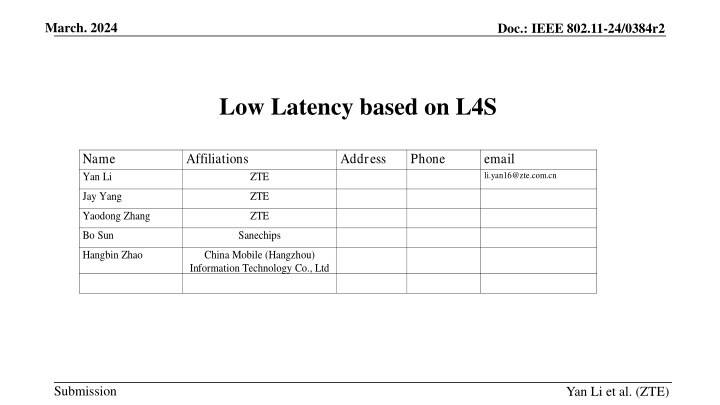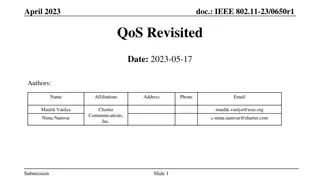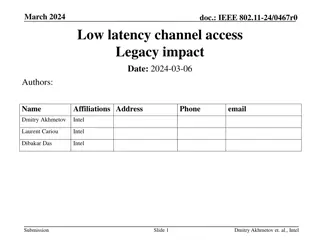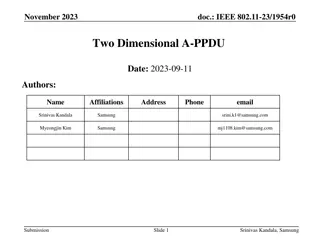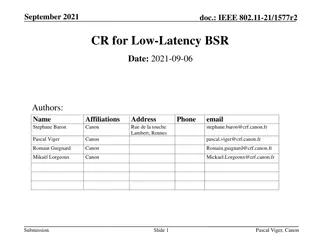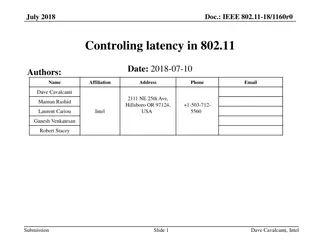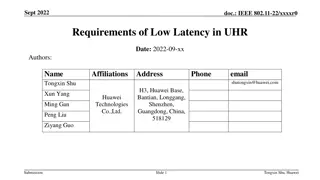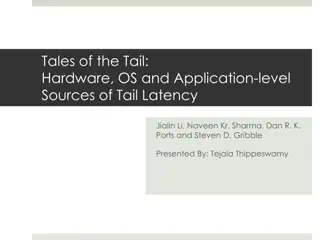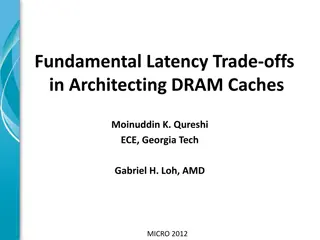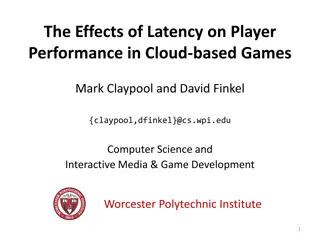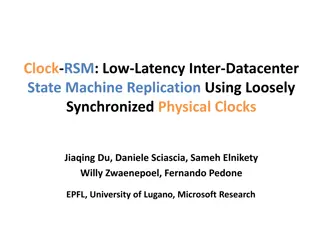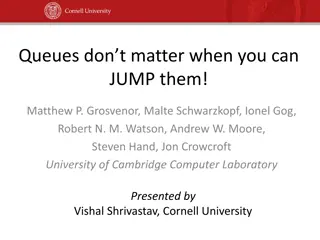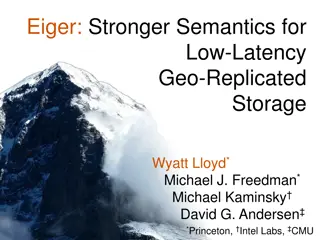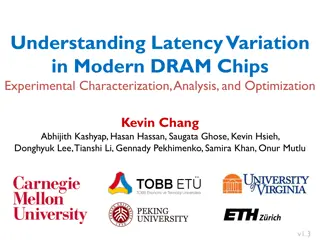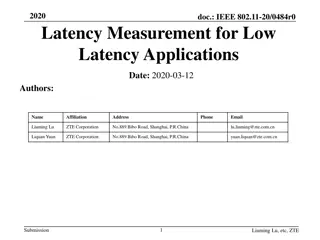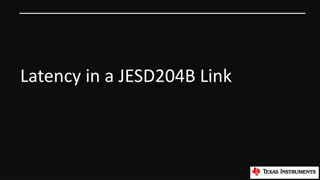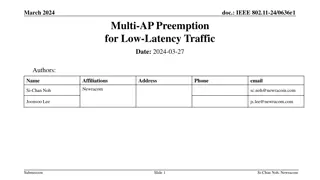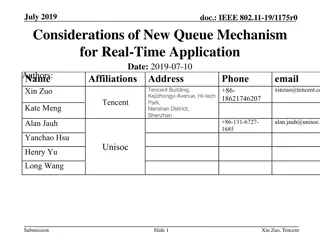Low Latency based on L4S
This document discusses the implementation of Low Latency in IEEE 802.11 networks based on the L4S (Low Latency, Low Loss, Scalable throughput) architecture. It explores the concept of congestion control, features, and motivation of Wi-Fi supporting L4S technology. The proposal extends the ECN (Explicit Congestion Notification) signal of L4S to the MAC layer for downlink transmissions, enhancing congestion management in WLAN links. Various contributions and simulations demonstrate the trade-off between throughput and latency, emphasizing the importance of reducing queuing delays in wireless networks.
Download Presentation

Please find below an Image/Link to download the presentation.
The content on the website is provided AS IS for your information and personal use only. It may not be sold, licensed, or shared on other websites without obtaining consent from the author.If you encounter any issues during the download, it is possible that the publisher has removed the file from their server.
You are allowed to download the files provided on this website for personal or commercial use, subject to the condition that they are used lawfully. All files are the property of their respective owners.
The content on the website is provided AS IS for your information and personal use only. It may not be sold, licensed, or shared on other websites without obtaining consent from the author.
E N D
Presentation Transcript
March. 2024 Doc.: IEEE 802.11-24/0384r2 Low Latency based on L4S Name Yan Li Affiliations Address Phone email li.yan16@zte.com.cn ZTE Jay Yang ZTE Yaodong Zhang ZTE Bo Sun Sanechips Hangbin Zhao China Mobile (Hangzhou) Information Technology Co., Ltd Submission Yan Li et al. (ZTE)
March. 2024 Doc.: IEEE 802.11-24/0384r2 Introduction 11bn PAR includes the reduction of tail latency in its scope of the project[1] Several contributions about L4S have proposed in the last few months [2] shares the concept of congestion control, L4S feature and motiviation of Wi-Fi supporting L4S [3] provides simulations of Wi-Fi supporting L4S, which indicates it s a tradeoff between throughput and latency comparing to classic queue, the L4S queue gains better latency performance with sacrificing a little bit throughput [4] proposes Dual Queue AQM (for AC_BE and AC_VI) to isolate L4S stream to guarantee its latency requirement This contribution proposes to extend ECN signal of L4S to MAC layer for the downlink, regardless of which AQM used(which means specific congestion monitoring and detection are out of scope) For classifying L4S MSDU, extension in TCLAS element if supporting SCS, and extension in MA-UNITDATA.request primitive if not supporting SCS Relevant congestion notification transmitted between AP and STA, while congestion occurs in MAC queue ECN signal in the MA-UNITDATA.indication to report congestion Submission Slide 2 Yan Li et al. (ZTE)
March. 2024 Doc.: IEEE 802.11-24/0384r2 Recap of queuing delay Bottleneck of end-to-end QoS includes WLAN links due to the wireless medium condition Quite amount of data buffered in the MAC queue leads to high queuing delay define the queuing delay(referencing [4]) as the duration from the time MSDU enters the MAC to the time contention starts, which precludes the medium access delay LLC data data Data packets MAC ... queuing delay WLAN links contend medium Submission Slide 3 Yan Li et al. (ZTE)
March. 2024 Doc.: IEEE 802.11-24/0384r2 Recap of ECN signal L4S uses ECN(explict congestion notification) to report congestion from layer 3 to above layer as shown in the bottom figure(e.g., cloud VR end-to-end transmission) 1. Sender transmits IP packet supporting L4S with ECT1 2. bottleneck node sets IP packet with CE|ECT1 when congestion occurs 3. Receiver gets above IP packet and reports congestion to TCP layer 4. Receiver transmits a TCP response with congestion flag in the TCP header 5. Sender adjusts its congestion window(i.e., lower sending rate) to mitigate queuing delay Submission Yan Li et al. (ZTE) Slide 4
March. 2024 Doc.: IEEE 802.11-24/0384r2 Motivation L4S has been widely used for low-latency, low-loss, and low-congestion internet services(such as online gaming, cloud service, and real-time application) As previous slide shows, L4S supports congestion notification(ECN) reported from layer 3 to layer 4 or above(e.g., from IP layer to TCP layer) To support L4S, the congestion notification should also be generated and reported to the above layer to finally mitigate the queuing delay, when congestion occurs in the MAC layer It more depends on the implementation whether congestion could be reported to layer 3 and it s allowed to modify the ECN field of the IP header of the relevant MSDU when MSDU still buffered in AP MAC queue. In this submission, it s assumed that congestion notification can only be added in the MAC layer and no modification can be added for the upper layer when the MSDU buffered in the AP MAC queue [5] introduces a method to report congestion from layer 2 to layer 4 for 802.1Q(i.e., wired transmission) Submission Slide 5 Yan Li et al. (ZTE)
March. 2024 Doc.: IEEE 802.11-24/0384r2 Propsoal 1-classify L4S(ECN capable) traffic Comparing to non-L4S traffic, L4S one may have different QoS requirement(e.g., delay bound) Traffic classification should involve L4S(ECN capable) field in the TCLAS element as shown in the below figure QoS characteristic element in the EHT SCS procedure may provide some parameters(or even a new queuing delay bound) as references for the AQM to detect whether the congestion happens PIE algorithm is based on current delay and target delay to detect if the congestion occurs Submission Slide 6 Yan Li et al. (ZTE)
March. 2024 Doc.: IEEE 802.11-24/0384r2 Propsoal 1-classify L4S(ECN capable) traffic (cont d) For supporting SCS, the current SCSID of MA_UNITDATA.request primitive can identify the corresponding L4S MSDU For not supporting SCS, a new L4S(ECN capable) parameter should be added in the MA_UNITDATA.request primitive to indicate the capability of L4S When identifying the L4S MSDU, diverse methods can provide assistence for the L4S MSDU(i.e., the dual-Q coupled AQM mentioned in [4] or many MAC features for low latency) Submission Slide 7 Yan Li et al. (ZTE)
March. 2024 Doc.: IEEE 802.11-24/0384r2 Proposal 2- report congestion signal to LLC (STA)When an MSDU comes to LLC layer from MAC layer, congestion flag(L4S-CE) should be added in the MA- UNITDATA.indication primitive to report the MSDU was congested in the AP MAC queue LLC or above layer will report such congestion notificaiton to IP layer and then it comes to the current L4S standard(may need 802.1Q to support such modification of this primitive) Submission Slide 8 Yan Li et al. (ZTE)
March. 2024 Doc.: IEEE 802.11-24/0384r2 Proposal 3- Congestion Notification in the air For the downlink, AP should provide congestion notification to the corresponding STA if the congestion occurs in the AP MAC queue(need more consideration on the ECN signal for the uplink) Option1: action frame Option2: data frame with congestion flag in the mac header(i.e., QoS field or A-control field) bind the congestion notification with each data frame where the encapsulated MSDU(s) suffered congestion when buffered in the AP MAC queue As the TCP sender may adjust its congestion window based on the amount of TCP response with congestion flag, (Option2)it s a better way to bind the congestion flag with relevant MSDU(s). Submission Slide 9 Yan Li et al. (ZTE)
March. 2024 Doc.: IEEE 802.11-24/0384r2 Illustration AP STA Proposal 1(1) SCS request[TCLAS(L4S/ECN capable),QoS characteristic] SCS response downlink data packet arrives MU-UNITDATA.request primitive(L4S/ECN capable) Proposal 1(2) Proposal 3 congestion occurs congestion notification congestion control monitoring and detection(out of scope) MU-UNITDATA.indication primitive(L4S-CE) Proposal 2 Submission Slide 10 Yan Li et al. (ZTE)
March. 2024 Doc.: IEEE 802.11-24/0384r2 Summary Analyze the queuing delay problem in MAC queue and share the L4S ECN feature (AP)Propose to support for classifying L4S/ECN capable MSDU by adding an L4S(ECN capable)field in the TCLAS element(if supporting SCS) by adding a new parameter in the MU-UNITDATA.request primitive(if not supporting SCS) (STA)Propose to add a parameter in the MU-UNITDATA.indication primitive for reporting congestion from mac layer to LLC layer Propose to transmit the congestion notification between AP and STA(assuming no change allowed for layer 3 or above when the MSDU buffered in AP MAC queue) Submission Slide 11 Yan Li et al. (ZTE)
March. 2024 Doc.: IEEE 802.11-24/0384r2 THANK YOU Submission
March. 2024 Doc.: IEEE 802.11-24/0384r2 Reference [1] 802.11bn PAR [2] 11-23-2065-00-0wng-l4s-and-implications-for-wi-fi [3] 11-24-0080-01-0arc-l4s-over-wi-fi-links [4] 11-23-0679-00-0uhr-low-latency-qos-based-on-l4s [5] 1-23-0034-01-ICne-congestion-signaling-csig Submission Slide 13
